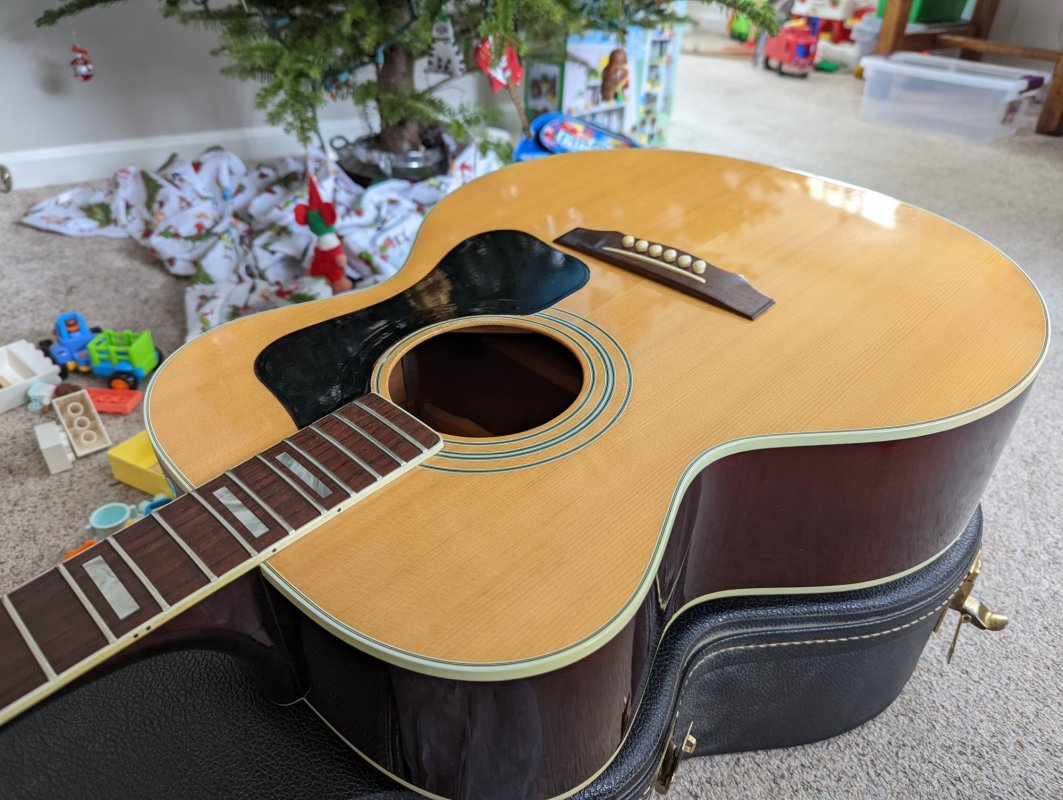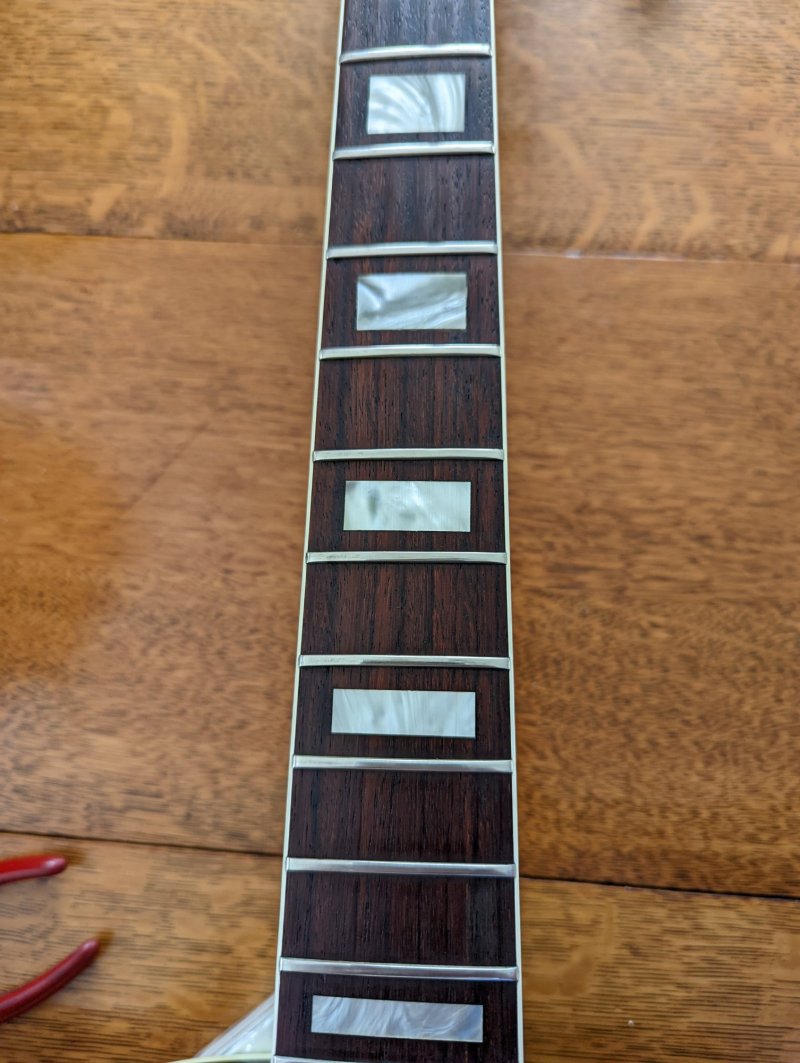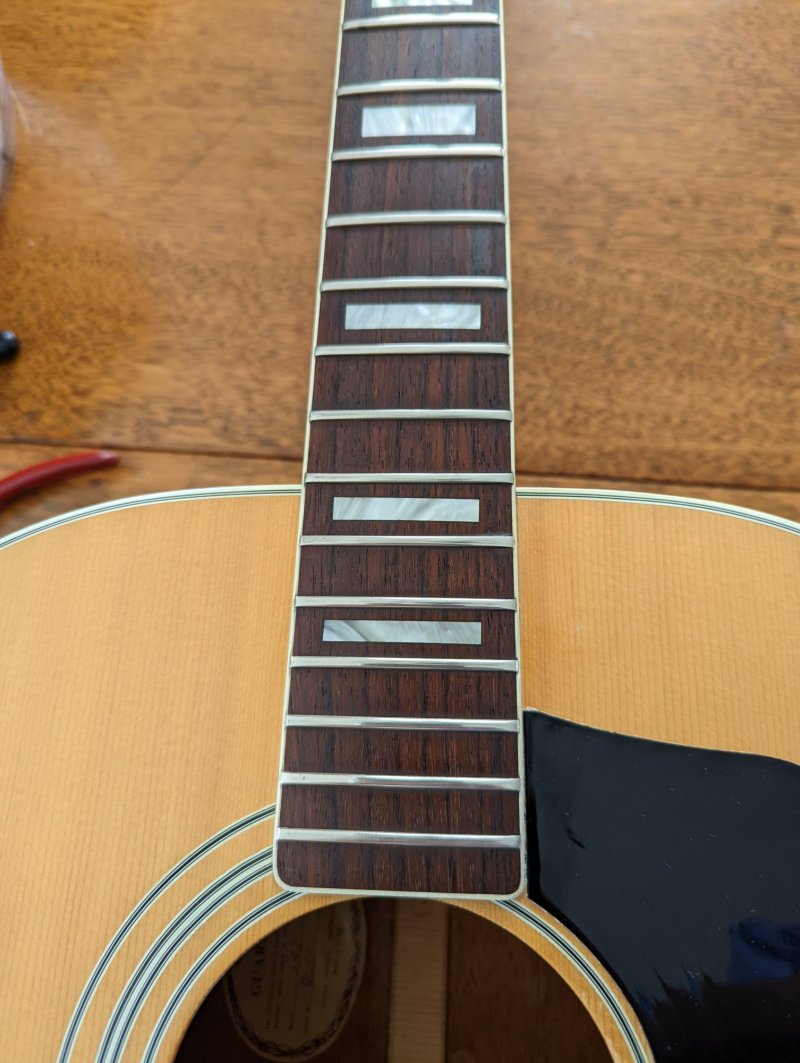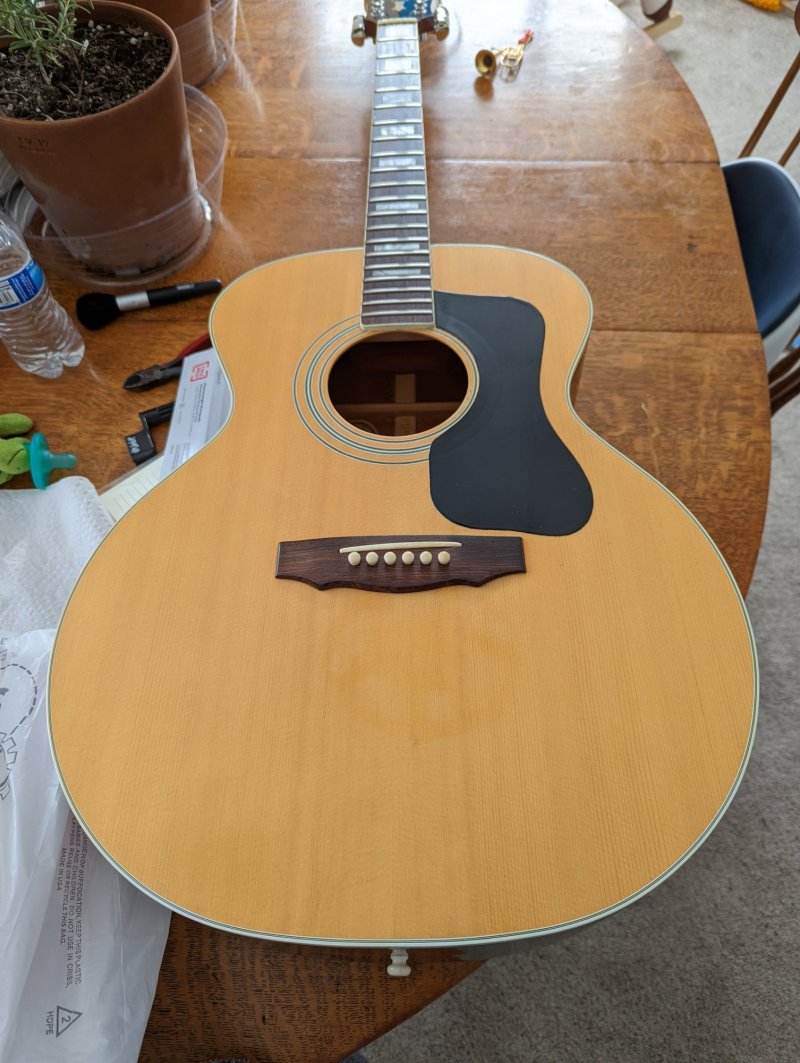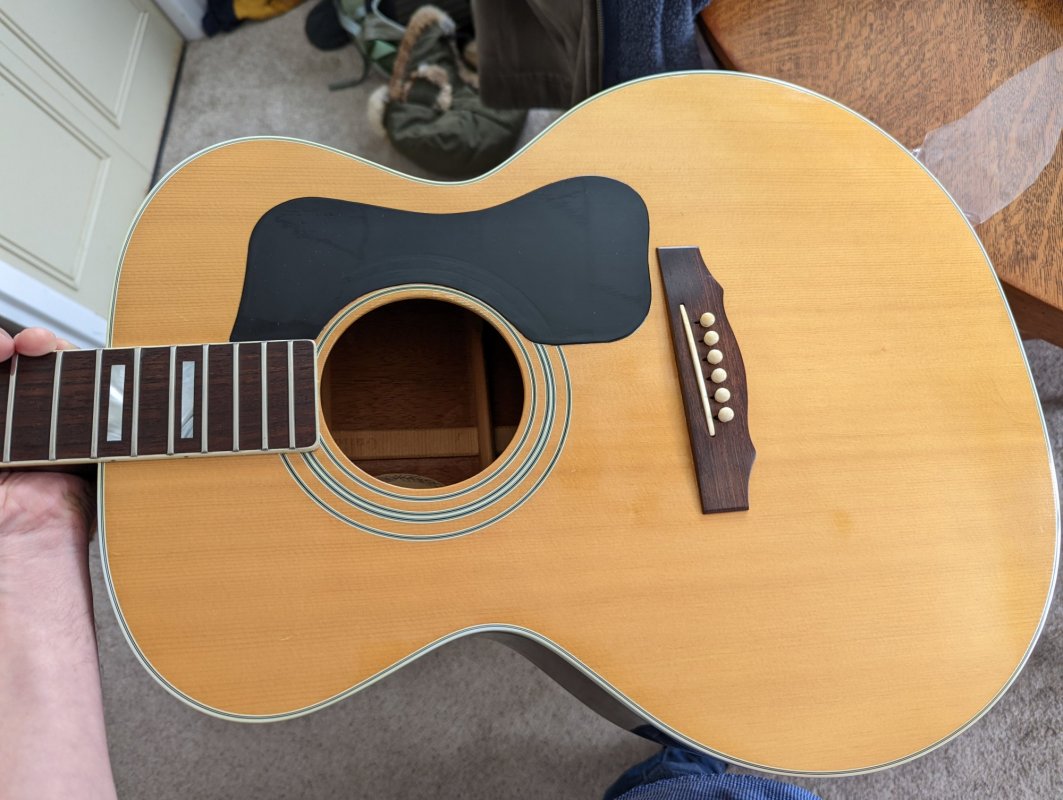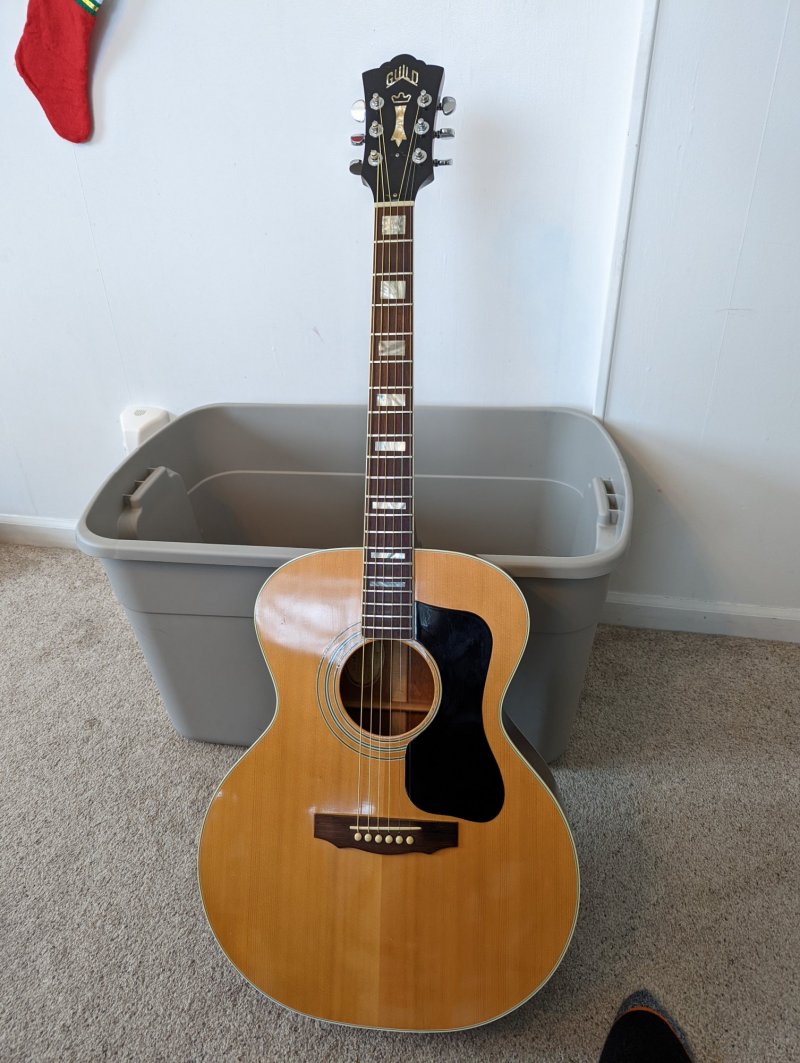Guildedagain
Venerated Member
Wiley/Glenn
Yes, you're doing it all wrong ;]
Wax on, let it dry, preferably, then wipe off. There really is an art to this, and it can also be done badly, I'm sure many here got in trouble trying to wax a car, uneven finish.
So while I prefer cotton I do use Scott blue towels cause they are throwaways, and it doesn't hurt to hydrate the cloth a little but you don't have to.
I shake the bottle up real good, and I squirt a dollop in the blue towel, squeeze it together, let it completely impregnate the cloth, no excess, rather the opposite.
By then, you've identified the problem areas, under the arm, around the bridge, etc, so start wiping the wax on, you can feel it cutting for just a second and it mellows out, keep buffing to the point of almost dry but do let it dry eventually. Do the whole guitar. That gives ares plenty of time to dry.
Walk away for a minute.
In good light from a window, start wiping the wax off with a different cloth, cotton preferred, or guitar poishing cloth.
Start at the top by the neck, and start swirling the cloth with decent pressure to wipe the wax off, and the wax will build up on the cloth and become a buffing pad.
Start coming down the guitar looking at the problem areas as you buff, and buff accordingly.
Get all the wax off in this buffing manner.
Re-examine the problem areas.
Do you need to repeat the process to get the gloss you're after?
Load the wax rag with more freshly shaken wax, about a teaspoon I'd say.
Go over the problem areas again, get em as shiny as you can without hurting the finish, and also you've got to recognize when dulling of the finish from years of sweat and neglect has dulled the finish to the point where it will not shine like the rest of the guitar, so be it, don't go through the finish.
I always concentrate on the top first, then the back and sides.
As others have pointed out, Virtuoso and others, there are guitar cleaner/polishes out there.
A bottle of Meguiar's lasts like 10 years for about 10 bucks, you should see what it does to old motorcycle paint.
DO NOT LET IT SIT at all.
Start wiping a 2 x 2" square around the frets, eat Wheaties that morning, get the cloth warm, start attacking the frets, here the fewer the better ;] Take your thumbnail, maybe with a nitrile glove on if you care about your health obsessively, and start attacking the topside of the frets across back and forth, each one will feel lumpy at first and immediately smooth out, elbow grease, lots of it.
Find a position that doesn't involve jamming the headstock into other furniture, but I like to hold the guitar on my lap.
Go over all the frets from top to bottom, cleaning the fret and board, it gets harder as they get closer.
Clean the bottoms of the fret wire across the frets, go back up to the top.
When the cloth is pure black and loaded with gunk, flip it over to the other side and repeat.
When the cloth is 100% used on both sides throw it away and start over with a new square, all the way down and back up the fret board until you are satisfied that everything is clean and polished, use both sides of the cloth fully, 2 squares usually do it.
Throw the second square away, these do not reuse.
Make sure to keep your Gorgomyte sealed in sealed bag between uses.
Take a dry sacrificial terry cloth face towel and go over all the frets and fretboard wiping away any residue until it is 100% and reasonably little black comes off the frets.
At this point you'll notice if the fret ends grab and shred the cloth, if they do, it's "fret sprout" and needs to be dealt with, at least for me.
I have a little tiny Swiss file made for this job, square, two filing surfaces, the same, and two blank - smooth - surfaces. You have to stay awake through the job and make sure the smooth surface is always down against the wood.
Every guitar has this problem where we live so I've learned to deal with it.
After Gorgomyte, the frets with feel incredibly smooth, and so will the board.
Tone is greatly improved.
I only say because I can't play a guitar with 20 years of someone's DNA on the fingerboard, so the guitar will be relatively toneless until I remove the crud from the fingerboard.
I used to think it was chic to have a roadworn looking guitar to the point where I had to clean my own Gibson fingerboard of 20 years of ownership to get it up for sale, and I could not get the junk off.
This is before I learned about Gorgomyte.
With Gorgomyte, everything is possible.
The future is Gorgomyte ;]
Thx GAD
Yes, you're doing it all wrong ;]
Wax on, let it dry, preferably, then wipe off. There really is an art to this, and it can also be done badly, I'm sure many here got in trouble trying to wax a car, uneven finish.
So while I prefer cotton I do use Scott blue towels cause they are throwaways, and it doesn't hurt to hydrate the cloth a little but you don't have to.
I shake the bottle up real good, and I squirt a dollop in the blue towel, squeeze it together, let it completely impregnate the cloth, no excess, rather the opposite.
By then, you've identified the problem areas, under the arm, around the bridge, etc, so start wiping the wax on, you can feel it cutting for just a second and it mellows out, keep buffing to the point of almost dry but do let it dry eventually. Do the whole guitar. That gives ares plenty of time to dry.
Walk away for a minute.
In good light from a window, start wiping the wax off with a different cloth, cotton preferred, or guitar poishing cloth.
Start at the top by the neck, and start swirling the cloth with decent pressure to wipe the wax off, and the wax will build up on the cloth and become a buffing pad.
Start coming down the guitar looking at the problem areas as you buff, and buff accordingly.
Get all the wax off in this buffing manner.
Re-examine the problem areas.
Do you need to repeat the process to get the gloss you're after?
Load the wax rag with more freshly shaken wax, about a teaspoon I'd say.
Go over the problem areas again, get em as shiny as you can without hurting the finish, and also you've got to recognize when dulling of the finish from years of sweat and neglect has dulled the finish to the point where it will not shine like the rest of the guitar, so be it, don't go through the finish.
I always concentrate on the top first, then the back and sides.
As others have pointed out, Virtuoso and others, there are guitar cleaner/polishes out there.
A bottle of Meguiar's lasts like 10 years for about 10 bucks, you should see what it does to old motorcycle paint.
Gorgomyte
DO NOT LET IT SIT at all.
Start wiping a 2 x 2" square around the frets, eat Wheaties that morning, get the cloth warm, start attacking the frets, here the fewer the better ;] Take your thumbnail, maybe with a nitrile glove on if you care about your health obsessively, and start attacking the topside of the frets across back and forth, each one will feel lumpy at first and immediately smooth out, elbow grease, lots of it.
Find a position that doesn't involve jamming the headstock into other furniture, but I like to hold the guitar on my lap.
Go over all the frets from top to bottom, cleaning the fret and board, it gets harder as they get closer.
Clean the bottoms of the fret wire across the frets, go back up to the top.
When the cloth is pure black and loaded with gunk, flip it over to the other side and repeat.
When the cloth is 100% used on both sides throw it away and start over with a new square, all the way down and back up the fret board until you are satisfied that everything is clean and polished, use both sides of the cloth fully, 2 squares usually do it.
Throw the second square away, these do not reuse.
Make sure to keep your Gorgomyte sealed in sealed bag between uses.
Take a dry sacrificial terry cloth face towel and go over all the frets and fretboard wiping away any residue until it is 100% and reasonably little black comes off the frets.
At this point you'll notice if the fret ends grab and shred the cloth, if they do, it's "fret sprout" and needs to be dealt with, at least for me.
I have a little tiny Swiss file made for this job, square, two filing surfaces, the same, and two blank - smooth - surfaces. You have to stay awake through the job and make sure the smooth surface is always down against the wood.
Every guitar has this problem where we live so I've learned to deal with it.
After Gorgomyte, the frets with feel incredibly smooth, and so will the board.
Tone is greatly improved.
I only say because I can't play a guitar with 20 years of someone's DNA on the fingerboard, so the guitar will be relatively toneless until I remove the crud from the fingerboard.
I used to think it was chic to have a roadworn looking guitar to the point where I had to clean my own Gibson fingerboard of 20 years of ownership to get it up for sale, and I could not get the junk off.
This is before I learned about Gorgomyte.
With Gorgomyte, everything is possible.
The future is Gorgomyte ;]
Thx GAD
Last edited:
